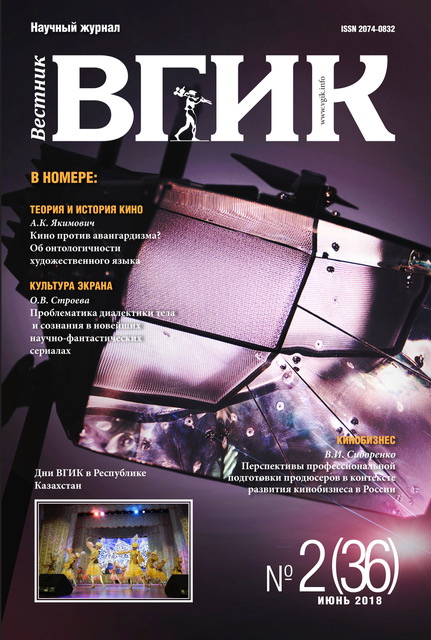Aesthetics of Interactivity: Between Game and Film. To Watch or to Play?
- Authors: Novikov V.N1
-
Affiliations:
- VGIK
- Issue: Vol 10, No 2 (2018)
- Pages: 50-60
- Section: PERFORMANCE | ART OF PRESENTATION
- URL: https://journals.eco-vector.com/2074-0832/article/view/14576
- DOI: https://doi.org/10.17816/VGIK10250-60
- ID: 14576
Cite item
Full Text
Abstract
According to recent research, video games are recognized as a new kind of art of the 21st century. Is it possible to distinguish the concepts of ‘‘entertainment’’ and ‘‘art’’ when dealing with this phenomenon? The purpose of this article is to analyze the significance of the game in contemporary society, to characterize the dominant features of ‘‘personal management’’ of a work of art, and to consider the influence of game aesthetics on the language of up-to-date cinema. The digital age, new technologies, computer modeling and virtual aesthetics modernized the classical thesis of ‘‘the life as a game’’ into a new philosophical concept. There are more and more attempts in succession to create a full-fledged virtual reality where a person could feel oneself to be an individualized god, commanding over all the processes taking place with the one and one’s life. The ultimate goal is the creation of such a global ‘‘game world’’ in which every person would be able to try oneself in any social role or avatar, building relationships with anyone, playing and enjoying it. So this desire for an interactive fusion of game forms with the objective reality that we are accustomed to is forming a rich and multilayered cultural platform nourishing diverse areas of contemporary art. The game industry has gone a long way of its development as a form of art. Nowadays video games and movies “imitate” each other and combine mixed aesthetic trends - the boundary between the Game and the Film is being increasingly blurred. On the one hand, games tend to cinema, using professional directing, scriptwriting and cast. On the other hand, mainstreamification of gaming technologies attracts many filmmakers looking for new artistic forms, concepts and visual mechanics that are interesting and relevant for contemporary mass audience.
Keywords
Full Text
Abstract: According to recent research, video games are recognized as a new kind of art in the 21st century. Is it possible to distinguish the concepts of ‘‘entertainment’’ and ‘‘art’’ when dealing with this phenomenon? The purpose of this article is to analyze the significance of the game in contemporary society, to characterize the dominant features of ‘‘personal management’’ of a work of art, and to consider the influence of game aesthetics on the language of up-to-date cinema.
The digital age, new technologies, computer modeling, and virtual aesthetics modernized the classical thesis of ‘‘the life as a game’’ into a new philosophical concept. There are more and more attempts in succession to create a full-fledged virtual reality where a person could feel oneself be an individualized god, commanding over all the processes taking place with the one and one’s life. The ultimate goal is the creation of such a global ‘‘game world’’ in which every person would be able to try oneself in any social role or avatar, building relationships with anyone, playing and enjoying it. So this desire for an interactive fusion of game forms with the objective reality that we are accustomed to is forming a rich and multilayered cultural platform nourishing diverse areas of contemporary art.
The game industry has gone a long way in its development as a form of art. Nowadays video games and movies “imitate” each other and combine mixed aesthetic trends — the boundary between the Game and the Film is being increasingly blurred. On the one hand, games tend to the cinema, using professional directing, scriptwriting and cast. On the other hand, mainstream fiction of gaming technologies attracts many filmmakers looking for new artistic forms, concepts and visual mechanics that are interesting and relevant for a contemporary mass audience.
About the authors
Vasily N Novikov
VGIK
Author for correspondence.
Email: vasily.novikov777@gmail.com
Post-Graduate student, VGIK
Russian Federation, MoscowReferences
- Роллингз Эндрю, Моррис Дэйв. Проектирование и архитектура игр: пер. с англ. - М.: Издательский дом «Вильямс», 2006. - 1040 с.
- Роттердамский Э. Философские произведения. - М.: Наука, 1987. - 702 с.
- Эйзенштейн С.М. Избранные произведения: в 6 т. Т. 3. - М.: Искусство, 1967. -672 с.
- Bordwell D. Making Meaning: Inference and Rhetoric in the Interpretation of Cinema. - Harvard University Press, 1991. - 348 p.
- Procci K., Bohnsack J., Bowers C.A. Patterns of gaming preferences and serious game effectiveness. - Proceedings of HCI, 2011. - 521 p.
- Verini J. Christopher Nolan’s Games // 'tte New Yorker // URL.: https://www. newyorker.com/ culture/culture-desk/ christopher-nolans-games (дата обращения: 05.02.2018)
Supplementary files








